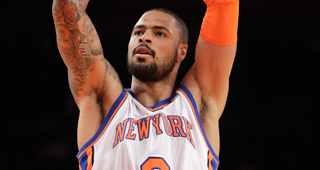Just as there aren’t many athletic 6’10+ basketball players in the world, there aren’t many quarterbacks with the footwork to keep plays alive in the pocket, the arm strength to fit balls into tight coverage and the decision-making ability to master the complexities of running an NFL offense.
A team can find a replacement-level guard in the D-League or a quality WR (Laurent Robinson) off the street, but quality big men, like good QB’s, are rare.
And after a lockout shortened offseason, the seasons of several NFL teams came down to how prepared they were at the backup QB position. Similarly, in a compressed 66-game regular season that magnifies the importance of depth, several NBA teams may be undone by a lack of even replacement-level big men coming off their bench.
The Kansas City Chiefs, the defending AFC West champions, collapsed after losing starting QB Matt Cassel to a hand injury. With Tyler Palko under center, they went 1-3 while averaging eight points per game. Palko, who had thrown only six passes in his career before the 2011 season, proved completely incapable of running an NFL offense. He threw for only 786 yards, with 2 TD’s and 7 INT’s, in his four starts.
His one victory came over a Chicago Bears team with Caleb Hanie at QB. Hanie had attempted only 14 passes before be the season, and in his four starts in place of the injured Jay Cutler, he completed only 50% of his passes for 613 yards, with three TDs and nine INTs. The Bears lost all four games, dropping from NFC contender to out of the playoffs entirely.
Now, only two weeks into the 2011-12 NBA season, it’s already clear that several teams came into the year woefully unprepared for their reserve big men to play significant minutes.
Against the Charlotte Bobcats last night, the New York Knicks kept Tyson Chandler and Amar'e Stoudemire on the floor for 40 minutes. Both injury-prone big men need to have their minutes carefully monitored, but it’s not like Mike D’Antoni has much of a choice, even against a 2-4 Charlotte team with a -11.0 point differential on the season.
Their main back-up is Josh Harrellson, an unathletic 6’11, 275 rookie who wasn’t highly regarded coming out of Kentucky and whose done little to prove he should even be on an NBA roster in his first six games. Per-36 minutes, he is averaging 6.6 points, 8.0 rebounds and 1.0 block on 26.1% shooting. Behind him is a 6’10 shooting specialist (Steve Novak), a 6’8 combo forward (Renaldo Balkman) and another 7’0 rookie project (Jerome Jordan).
And while “Lob City” has been one of the big stories of the early NBA season, there isn’t much frontcourt depth behind DeAndre Jordan and Blake Griffin. Through six games, their back-up center (6’10 Brian Cook) and back-up power forward (6’7 Ryan Gomes) have combined for two blocks.
Of course, a good third big man, like a good back-up QB, is hard to find.
But the best run franchises don’t just throw their hands up and pray for good health, they pro-actively search for prospects and use the back end of their bench to develop players for the future.
After two blowouts to the Miami Heat and the Denver Nuggets to open the season, it was clear the Dallas Mavericks could not hope to compete with a big man rotation of Brendan Haywood, Dirk Nowitzki and Lamar Odom. However, unlike the Knicks or the Clippers, they had options on their roster: Ian Mahinmi, an athletic 6’11+ center they picked up in free agency last year and used as their third center, and Sean Williams, a former New Jersey Nets first-round pick who turned around his career playing for the Mavericks’ D-League affiliate last season.
Even more remarkably, because they found UNC rookie T.J. Yates in the fifth round, the Houston Texans were able to make the 2011 playoffs despite losing both starting QB Matt Schaub and backup Matt Leinart to season-ending injuries. Yates hasn’t been spectacular, but he’s been competent enough to keep Houston afloat, unlike Palko or Hanie.
In a system with payroll limits, it’s even more important to find young players, and their comparatively smaller salaries, in the draft.
After injuries to power forwards Darrell Arthur and Zach Randolph, the Memphis Grizzlies once promising season is now on the brink. But if they had hit on the No. 2 overall pick in the 2009 draft, selecting a big man capable of playing 25-30 minutes a night instead of Hasheem Thabeet, they’d be much better prepared to survive their injury epidemic. Instead, they had to give up on their No. 12 pick in 2010, Xavier Henry, a super-athletic 20-year-old 6’6 guard out of Kansas, to acquire a post player (Marreese Speights) to fill the gaping hole in their rotation.
Because of the magnified importance of star players in the NBA, many teams neglect their end of their bench, which came back to bite Miami and the Lakers in last year’s playoffs. After all, even if Chandler and Amare play 40 minutes a night in April and May, how confident can the Knicks be with Josh Harrelson defending the paint for any amount of time against the Heat or the Bulls?

Jonathan Tjarks wrote on the NBA for RealGM from 2011-2016 before joining The Ringer.
Follow @JonathanTjarks on Twitter.


